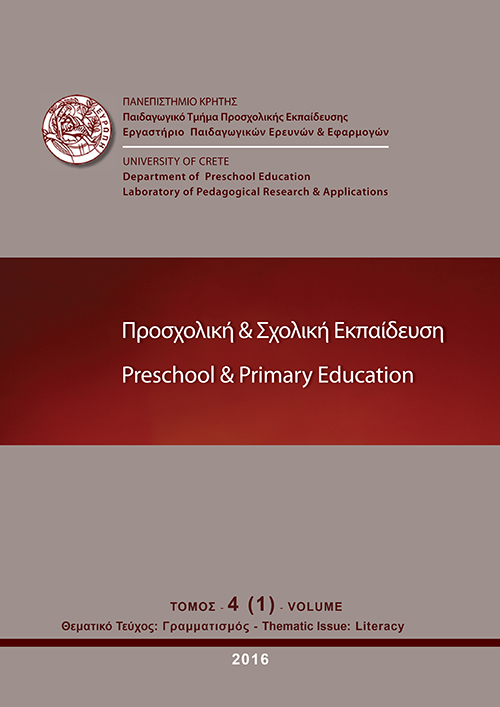Η απαιτητική ανάγνωση των εικόνων στα εικονογραφημένα βιβλία του Σαραμάγκου

Περίληψη
Λεπτομέρειες άρθρου
- Πώς να δημιουργήσετε Αναφορές
-
Kaliakatsou, I., & Giannikopoulou, A. (2016). Η απαιτητική ανάγνωση των εικόνων στα εικονογραφημένα βιβλία του Σαραμάγκου. Preschool and Primary Education, 4(1), 68–84. https://doi.org/10.12681/ppej.228
- Ενότητα
- Άρθρα

Αυτή η εργασία είναι αδειοδοτημένη υπό το CC Αναφορά Δημιουργού – Μη Εμπορική Χρήση – Παρόμοια Διανομή 4.0.
Οι συγγραφείς των άρθρων που δημοσιεύονται στο ΠΡΟΣΧΟΛΙΚΗ & ΣΧΟΛΙΚΗ ΕΚΠΑΙΔΕΥΣΗ διατηρούν τα δικαιώματα πνευματικής ιδιοκτησίας επί των άρθρων τους, δίνοντας στο περιοδικό το δικαίωμα της πρώτης δημοσίευσης. Άρθρα που δημοσιεύονται στο ΠΡΟΣΧΟΛΙΚΗ & ΣΧΟΛΙΚΗ ΕΚΠΑΙΔΕΥΣΗ διατίθενται με άδεια Creative Commons 3.0 και σύμφωνα με την άδεια μπορούν να χρησιμοποιούνται ελεύθερα, με αναφορά στο/στη συγγραφέα και στην πρώτη δημοσίευση για μη κερδοσκοπικούς σκοπούς και με δικαίωμα τροποποίησης μόνον με παρόμοια διανομή (αν αναμείξετε, τροποποιήσετε, ή δημιουργήσετε πάνω στο υλικό, πρέπει να διανείμετε τις δικές σας συνεισφορές υπό την ίδια άδεια όπως και το πρωτότυπο). To Εργαστήριο Παιδαγωγικών Ερευνών και Εφαρμογών του Παιδαγωγικού Τμήματος Προσχολικής Εκπαίδευσης του Πανεπιστημίου Κρήτης και το Εθνικό Κέντρο Τεκμηρίωσης διατηρούν το δικαίωμα να δημοσιεύουν, να αναπαραγάγουν, να παρουσιάζουν στο κοινό, να διανέμουν και χρησιμοποιούν άρθρα που δημοσιεύονται στο ΠΡΟΣΧΟΛΙΚΗ & ΣΧΟΛΙΚΗ ΕΚΠΑΙΔΕΥΣΗ σε οποιοδήποτε μέσο και μορφή είτε μεμονωμένα είτε ως μέρη συλλογικών έργων, για όλο το χρόνο διάρκειας προστασίας της πνευματικής ιδιοκτησίας και για όλες τις χώρες του κόσμου. Αυτό περιλαμβάνει ενδεικτικά και όχι αποκλειστικά, το δικαίωμα δημοσίευσης των άρθρων σε τεύχη του περιοδικού ΠΡΟΣΧΟΛΙΚΗ & ΣΧΟΛΙΚΗ ΕΚΠΑΙΔΕΥΣΗ, αναπαραγωγής και διανομής μεμονωμένων αντιγράφων των άρθρων, αναπαραγωγής ολόκληρων των άρθρων σε άλλη έκδοση του Εργαστηρίου Παιδαγωγικών Ερευνών και Εφαρμογών του Παιδαγωγικού Τμήματος Προσχολικής Εκπαίδευσης του Πανεπιστημίου Κρήτης και του Εθνικού Κέντρου Τεκμηρίωσης και αναπαραγωγής και διανομής των άρθρων ή περίληψης αυτών με χρήση πληροφορικού συστήματος αποθετηρίου.
Λήψεις
Αναφορές
Arizpe, E. & Styles, M.(2003) Children reading pictures: Interpreting visual texts. London: RoutledgeFalmer.
Bachelard G.(1997), I epoptia tis stigmis [The intuition of the instant], trans. Papagiorgis Kostis, Athens: Kastaniotis
Barrentine , S. J. (1996) Engaging with reading through interactive read-alouds. The Reading Teacher, vol.50, no 1, 36-43.
Bergson, H. (1922) Creative Evolution. Trans. Arthur Mitchell, London: Macmillan and Co. Retrieved March 2015 from: https://archive.org/details/creativeevolutio00berguoft
Boym, S. (2001). The future of nostalgia. New York: Basic Books.
Boym, S.(2007) Nostalgia and its Discontents. The Hedgehog Review Vol.9 No2 7-17
Callow, J. (2008). Show me: Principles for Assessing Students’ Visual Literacy. The Reading Teacher, vol.61, no 8, 616-626.
Goldstone, B. P. (1998). Ordering the Chaos: Teaching Metafictive Characteristics of Children's Books.Journal of Children's Literature, v24 n2, 48-55.
Goldstone, B. P. (2001) Whaz up with our books? Changing Picture Book Codes and Teaching Implications. The Reading Teacher, Vol.55, No 4, 48-55.
Iser, W. (1978) The Act of Reading:A Theory of Aesthetic Response. Baltimore:Johns Hopkins UP.
Lukacs, G. (2004) I Theoria tou Mithistorimatos [The Theory of the Novel], Trans.Tselenti X., Athens: Politropon.
McCallum R. (1996). Metafictions and Experimental Work. Hunt P. (ed) International Companion Encyclopedia of Childrens Literature, (p.p. 397-409), New York: Routledge.
McGavran, J.Η. (1999). Literature and the Child: Romantic Continuations, Postmodern Contestations. Iowa City: University of Iowa Press.
Moss, G.(1990). Metafiction and the Poetics of Children's Literature. Children's Literature Association Quarterly, Vol.15, No 2, 50-52.
Nikolajeva M.& Scott C.(2001) How Picturebooks Work NY: Garland
Pantaleo, S. (2004).Young Children Interpret the Metafictive in Anthony Browne’s Voices in the Park. Journal of Early Childhood Literacy, vol. 4, no. 2, 211-233.
Pantaleo, S. & Sipe L. R.(2008). Postmodern Picturebooks: Play, Parody, and Self-Referentiality. New York: Routledge.
Ryan M. & Anstey M. (2003). Identity and Text: Developing Self-Conscious Readers. Australian Journal of Language and Literature, Vol.26, No 1, 9-22.
Saramago José (2006). To megalitero louloudi tou kosmou [The Biggest Flower in the World], Ill. Joᾱo Caetano,Trans. Ath. Psillia, Athens: Kastaniotis.
Saramago José (2008). Mikres anamnisis: autobiografia [Small Memories: Autobiography], Trans. Ath. Psillia, Athens: Kastaniotis.
Saramago José (2012). I siopi tou nerou [The Silence of the Water], Ill. Manuel Estrada,Trans. Ath. Psillia, Athens: Kastaniotis.
Serafini, F. (2004). Lessons in comprehension: Explicit instruction in the reading workshop. Portsmouth, NH: Heinemann.
Serafini, F.(2005). Voices in the Park, Voices in the Classroom: Readers Responding to Postmodern Picture Books. Reading Research and Instruction, Vol.44, n.3 Retrieved online on March 2015 from:
http://www.google.gr/url?sa=t&rct=j&q=&esrc=s&source=web&cd=1&ved=0CCMQFjAAahUKEwjGkqrj047GAhWBWRQKHdtTAGE&url=http%3A%2F%2Fwww.frankserafini.com%2Fpublications%2Fserafini-voices.pdf&ei=Pyx9VYb3GIGzUdungYgG&usg=AFQjCNEkZS-A-QHuCe2BwhP7YQXF4xf09w&bvm=bv.95515949,d.d24&cad=rja
Sipe L. (2000). The construction of literary understanding by first and second graders in oral response to picture storybooks read-alouds. Reading Research Quarterly, Vol.35, No2, 252-275
Trites R. S. (1994) Manifold narratives. Metafiction and Ideology in Picturebooks. Children’s Literature in Education, Vol.25, 225-242
Walsh, M. (2003)Reading' pictures: What do they reveal? Young children's reading of visual texts. Reading: Literacy and Language, Vol 37 No3, 123-130.
Waugh, P. (1984). Metafiction: The Theory and Practice of Self-Conscious Fiction. New York: Methuen


